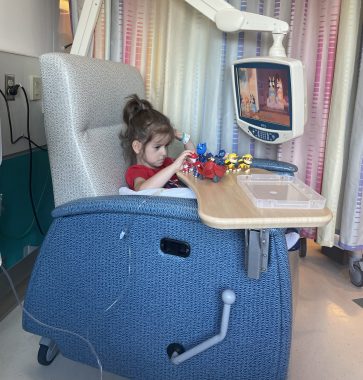The Long Drive for My Son’s Nexviazyme Infusions Is Worth It
Written by |

Recently, my 4-year-old son, Cayden, made the long-awaited change to Nexviazyme (avalglucosidase alfa) infusions, a new treatment option for Pompe disease. We have wanted to switch treatments for a while, but faced some insurance challenges that caused a delay. Nevertheless, we finally managed to get him switched, and he had his second Nexviazyme infusion last week.
While we are no strangers to enzyme replacement infusions, things have been a bit different since the change. Previously, Cayden had received weekly Lumizyme (alglucosidase alfa) infusions since he was 1 month old, which required us to stay overnight at a children’s hospital about 2.5 hours away. Eventually, when he was about 18 months old, we started home infusions, which was a huge game changer.
Because Cayden had never received Nexviazyme before, his doctors require that we go to the infusion clinic at the children’s hospital for the first three or four infusions. I have no issue with this, as they are simply making sure that he does well with the new medication and doesn’t have a reaction. However, there are some notable differences between getting infusions at the clinic and getting them as an inpatient or at home.
Early to rise
For starters, we must wake up very early for the long drive to the infusion clinic. They have been scheduling his infusions for 9 a.m., so we leave our house at 6 a.m. to arrive on time. When he was receiving infusions at home, the nurse arrived at 8 a.m., which allowed us more time to sleep in. Cayden is not a morning person, and frankly, neither am I. However, I will do whatever is necessary for my son.
Another thing that’s different is the setting at the infusion clinic. When Cayden was younger, he received Lumizyme infusions while sleeping in a crib as an inpatient. The infusion clinic, however, has a chair for him to sit in while he is treated with Nexviazyme. It’s not the most comfortable thing in the world, but it does recline, so he can take a nap if he chooses.

Cayden receives Nexviazyme treatment at an infusion clinic. (Photo by Keara Engle)
The infusions also have taken longer than what we were used to. The infusion rate is slower because he had never received this medication before, which helps to prevent a negative reaction. Thankfully, he hasn’t had one, and we are hopeful he never does.
While the days at the infusion clinic are long, the staff has been doing everything possible to make sure that Cayden is entertained and content. Child life specialists bring various toys and have activities to keep him busy. The nurses always hook up a TV for him to enjoy his favorite shows.
I am eager to get back to home infusions, but I acknowledge that the infusion clinic has been amazing. I was worried that Cayden would get bored and start complaining, but he hasn’t so far. We sure do miss our home infusion nurse and can’t wait to see her again. Thankfully, Cayden needs only one or two more infusions at the clinic before we can switch.
I am so grateful he was given the opportunity to receive Nexviazyme, even if it means we must spend a few long days at the clinic.
Note: Pompe Disease News is strictly a news and information website about the disease. It does not provide medical advice, diagnosis, or treatment. This content is not intended to be a substitute for professional medical advice, diagnosis, or treatment. Always seek the advice of your physician or other qualified health provider with any questions you may have regarding a medical condition. Never disregard professional medical advice or delay in seeking it because of something you have read on this website. The opinions expressed in this column are not those of Pompe Disease News or its parent company, Bionews, and are intended to spark discussion about issues pertaining to Pompe disease.







Leave a comment
Fill in the required fields to post. Your email address will not be published.